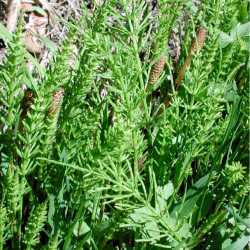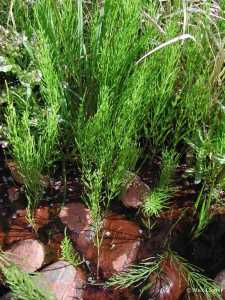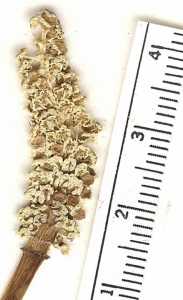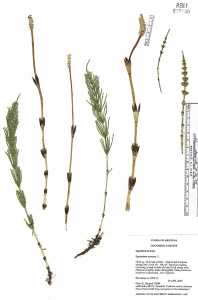Aerial stems dimorphic; vegetative stems green, branched, 2--60(--100) cm; hollow center 1/3--2/3 stem diam. Sheaths squarish in face view, 2--5(--10) × 2--5(--9) mm; teeth dark, 4--14, narrow, 1--3.5 mm, often cohering in pairs. Branches in regular whorls, ascending, solid; ridges 3--4; valleys channeled; 1st internode of each branch longer than subtending stem sheath; sheath teeth attenuate. Fertile stems brown, lacking stomates, unbranched, shorter than vegetative stems, with larger sheaths, fleshy, ephemeral. 2 n =ca. 216.
Cones maturing in early spring. Roadsides, riverbanks, fields, marshes, pastures, tundra; 0--3200 m; Greenland; St. Pierre and Miquelon; Alta., B.C., Man., N.B., Nfld., N.W.T., N.S., Ont., P.E.I., Que., Sask., Yukon; all states except Fla., La., Miss., S.C.; Eurasia s to Himalayas, c China, Korea, Japan.
Among the many infraspecific taxa that have been named in this species, Equisetum arvense var. boreale Bongard has been most generally accepted and has been applied to plants with tall, erect stems with 3-ridged branches. Because both 3-ridged and 4-ridged branches may occur on a single stem, the variety boreale is not recognized here as distinct (R.L. Hauke 1966).
AERIAL STEMS: dimorphic, erect, the surface smooth; fertile stems 7-35 cm long, ephemeral, tan to pink, unbranched; vegetative stems 10-60 cm long, 5-14-ridged, persisting through 1 growing season, green, with regular whorls of branches, these 3- or 4-ridged.
SHEATHS: as long as or longer than wide, lacking bands or markings; teeth 5-14 per sheath (3-4 on branches), 1-3 mm long (-8 mm on fertile stems), mostly black, persistent.
STROBILI: 5-35 mm long, the tips rounded.
SPORES: 35-70 μm in diameter.
NOTES: Wet soil of montane meadows and stream banks, less commonly on moist rock ledges: Apache, Coconino, Gila, Graham, Mohave, Navajo, Pima, Yavapai cos. (Fig. 1A); 1400-2700 m (4500-8800 ft); nearly worldwide. The fertile stems of E. arvense are produced in April and May before the vegetative ones and wither soon after the spores are shed. They tend to be stouter than the vegetative stems, with fewer ridges and larger sheaths. The vegetative stems have regular whorls of branches, these with only 3-4 ridges. Care must be taken not to confuse these branches with those of wound-forms of other Arizona species, which develop following damage by flood-waters, and which occur irregularly and generally have more ridges.
REFERENCES: G.Yatskievych and M.D. Windham , 2008, Vascular Plants of Arizona: Equisetaceae. CANOTIA 4 (2): 41-45.
General: Dimorphic and erect aerial stems with smooth surface; fertile stems 7-35 cm, ephemeral, tan to pink, unbranched.
Leaves: Vegetative stems 10-60 cm long, 5-14 ridged, persistent through one growing season, green, with regular whorls of branches, these each 3-4 ridged; sheaths long as or longer than wide, lacking bands or markings with 5-14 teen per sheath, 3-4 on branches, each 1-3 mm long, mostly black and persistent.
Sporangia: Terminal strobili 5-35 mm long, the tips rounded.
Ecology: Found in wet soil of meadows and on stream banks from 4,500-9,000 ft (1372-2743 m); sporulates in April-May.
Notes: Fertile stems are produced before vegetative ones, are stouter than the latter and have fewer ridges and larger sheaths. Pay attention to the form of the branches of this species in order to tell them apart from flood damaged specimens of other species.
Ethnobotany: A poultice was used for chafing in underarms and groin, used as a powerful diuretic and taken for the kidneys, constipation, as a veterinary aid, for headaches and pains, for rheumatism, joint aches, the stems were chewed by teething babies, used to wash body for poison ivy, syphilis and gonorrhea, for other open sores, lumbago, bladder problems, though to be good for the blood when tender young shoots were eaten, stems used as food, fodder, the tubers were eaten, made into dye, the roots were used in basketry, for toys, used as whistles, and as a file.
Etymology: Equisetum is from equus, horse and seta, bristle, while arvense means of the fields.
Sources: Yatskievych and Windham 2008
Common Name: field horsetail
Wetland Status: FAC
Rarity: None
General: Dimorphic and erect aerial stems with smooth surface; fertile stems 7-35 cm, ephemeral, tan to pink, unbranched.
Leaves: Vegetative stems 10-60 cm long, 5-14 ridged, persistent through one growing season, green, with regular whorls of branches, these each 3-4 ridged; sheaths long as or longer than wide, lacking bands or markings with 5-14 teen per sheath, 3-4 on branches, each 1-3 mm long, mostly black and persistent.
Sporangia: Terminal strobili 5-35 mm long, the tips rounded.
Ecology: Found in wet soil of meadows and on stream banks from 4,500-9,000 ft (1372-2743 m); sporulates in April-May.
Notes: Fertile stems are produced before vegetative ones, are stouter than the latter and have fewer ridges and larger sheaths. Pay attention to the form of the branches of this species in order to tell them apart from flood damaged specimens of other species.
Ethnobotany: A poultice was used for chafing in underarms and groin, used as a powerful diuretic and taken for the kidneys, constipation, as a veterinary aid, for headaches and pains, for rheumatism, joint aches, the stems were chewed by teething babies, used to wash body for poison ivy, syphilis and gonorrhea, for other open sores, lumbago, bladder problems, though to be good for the blood when tender young shoots were eaten, stems used as food, fodder, the tubers were eaten, made into dye, the roots were used in basketry, for toys, used as whistles, and as a file.
Etymology: Equisetum is from equus, horse and seta, bristle, while arvense means of the fields.
Synonyms: Equisetum arvense var. alpestre, Equisetum arvense var. boreale, Equisetum arvense var. campestre, Equisetum arvense var. riparium, Equisetum calderi
Editor: SBuckley, 2010
Stems annual, dimorphic, the sterile ones 1.5-6(-10) dm, 1.5-5 mm thick, (4-)10-14-ridged, with well developed vallecular cavities and small central cavity ca 1/4 the diameter of the stem; the stomates in 2 broad bands in the furrows, the sheath 5-10 mm, with persistent, brown, free or partly connate teeth 1.5-2 mm; branches regularly whorled at the middle and upper nodes, 3-4-angled, solid, sometimes again branched, the first internode longer than the associated stem- sheath; fertile stems whitish to brownish, precocious and soon withering, to 3 dm, simple, to 8 mm thick, their sheaths 14-20 mm, with large, partly connate teeth 5-9 mm; cones long-pedunculate, 0.5-3.5 cm, not apiculate. Cosmopolitan, somewhat weedy; in moist to moderately dry habitats throughout our range.
Gleason, Henry A. & Cronquist, Arthur J. 1991. Manual of vascular plants of northeastern United States and adjacent Canada. lxxv + 910 pp.
©The New York Botanical Garden. All rights reserved. Used by permission.










